
Rediscovering Japan

Rediscovering Japan
Travel (Gifu Part 1 (Hida Furukawa))

by tomizuta
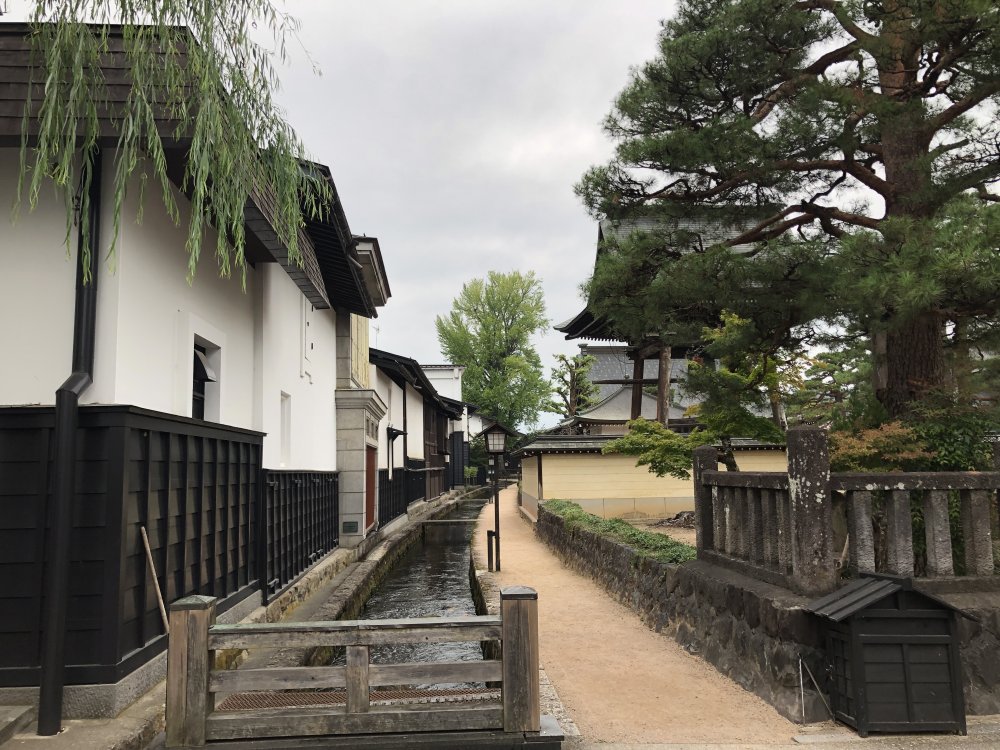
A view of the Setogawa Canal and White-walled Storehouse Street maintaining its feature from the Edo era in the heart of the township of Hida Furukawa.
There were three areas in Gifu that I had longed to explore, Takayama, Shirakawago, and Hida Furukawa. I had been to Takayama more than thirty years ago. But when a couple from the UK that I had the opportunity to guide in Tokyo told me this April (2023) that their next destination was Takayama, I really thought that I must revisit the city. I knew of Shirakawago, now a World Heritage, from my geography text book at elementary school, but never had the opportunity to visit. I learned about Hida Furukawa through a TV drama series featuring murder cases in the numerous Little Kyoto cities, of which one case featured Hida Furukawa. Little Kyotos are so-called because of their resemblance to Kyoto with its rivers, temples and traditional handcrafts. In most cases this was a result of feudal lords assigned to regional feudal domains wishing to replicate Kyoto in their assigned domains. I had wanted to book a group tour in Takayama in September that had been announced earlier, but found that it had been canceled due to a resurge of the coronavirus. So I went ahead to arrange my own visit to the three areas all in close proximity of each other.
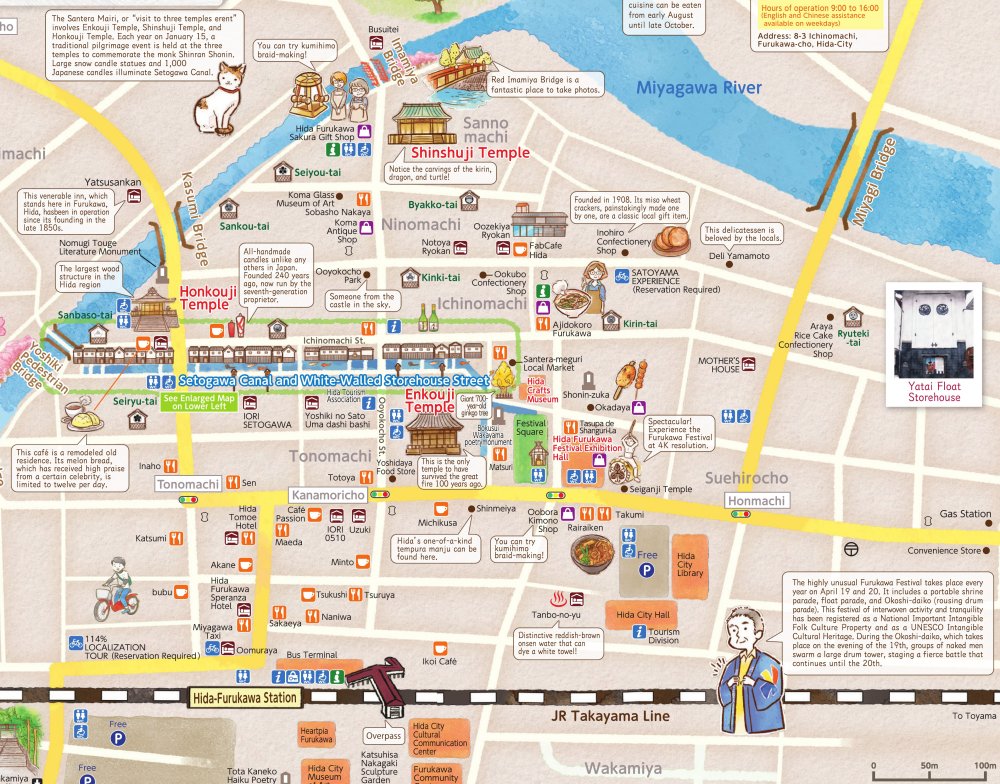
A map of the township of Hida Furukawa extracted from the brochure downloadable from Hida City's website. Although the map is small, it'll give you an idea on how I traveled. I started from the free car park on the lower right, followed the white-walled storehouse street to visit the three temples in the town. The last place I visited was the Ketawakamiya Shinto Shrine about 1km south of Hida Furukawa Station on the lower left. As can be seen from the map scale on the bottom right, you will be able to visit most of the places in half a day.
I started my trip in late September 2023 from Hida Furukawa, which turned out to be much more interesting than I had expected. The center of Furukawa, now part of Hida City is located about 15 kilometers north of Takayama City. It is at an altitude of approximately 500 meters above sea level on a plateau, the only plain in Hida City with over 90% mountains and forest. Archaeological evidence shows that people have lived here from as early as the early Jomon era (5000 B.C.). The area went under the control of the Imperial government governed by the regional government office (Kokufu) established in between Furukawa and Takayama (the area has retained the name Kokufu). Later, various feudal lords fought over the area, as it was one of the best rice growing areas in the Hida region as well as being a timber source. But the current township of Furukawa with all of its rich tradition was developed from the late 16th century, after Nagachika Kanamori conquered the Hida region and was made the feudal lord of Hida by Hideyoshi Toyotomi. I am ashamed to confess that it was not until this visit that I learned that it was Nagachika Kanamori that established the beauty of the two little Kyotos, Takayama and Furukawa, as well as how popular he still is among the local people. It is also incredible that, before becoming the feudal lord of Hida, Nagachika was the lord of Echizen Ono in Fukui Prefecture, the city of which is known as the Little Kyoto of Echizen.
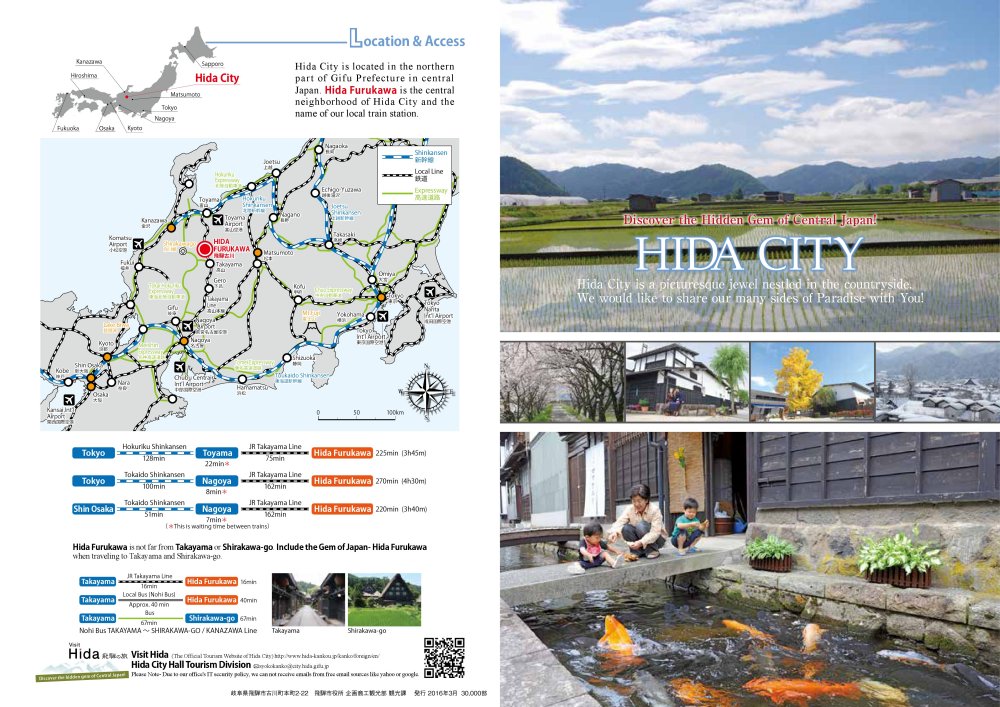
Furukawa, now part of Hida City is only 15 kilometers north of Takayama City. I assure you that it would be worthwhile to include Furukawa to your trip when visiting Takayama and Shirakawa-go, as the small town has certainly well preserved its Edo era style town features as well as tradition, and you may be able to gain valuable insight to the other places you visit in the Hida region.
The current township of Furukawa was established as a castle town, when
in 1586, a year after becoming the feudal lord of Hida, Nagachika Kanamori
built Masushima Castle as a satellite of the castle in Takayama from where
he governed. The town was developed with Masushima Castle at the very north,
the samurai residence area directly south, and the merchant and commoner
area to the east separated by a narrow canal. The Kanamori Family were
reassigned to a feudal domain in Yamagata Prefecture, Hida became under
direct control of the Tokugawa shogunate in the late 17th century, upon
which Masushima Castle and the samurai residence area were all dismantled.
I arrived around noon time and parked in the free parking space of the
city hall and library. I had planned to enjoy soba noodles at a soba restaurant
but found it to be closed. It was a Wednesday and not a regular closed
day. I warn tourists that many restaurants in the Hida area seem to not
open on an irregular base. In my trip pre-study, I had learned that I should
try local hand-kneaded soba (teuchi-soba) with an above average strength.
Luckily, I found a restaurant serving teuchisoba, where out of their recommended
menus I chose their Hida beef sinew soba. This is a warm soba with stewed
Hida beef sinew as a topping. I was quite impressed with the stewed sinew
as well as the quality of the soba, which certainly made a good start.
During the rest of my stay, I was tempted to order Hida beef as a steak
as well as stewed sinew.
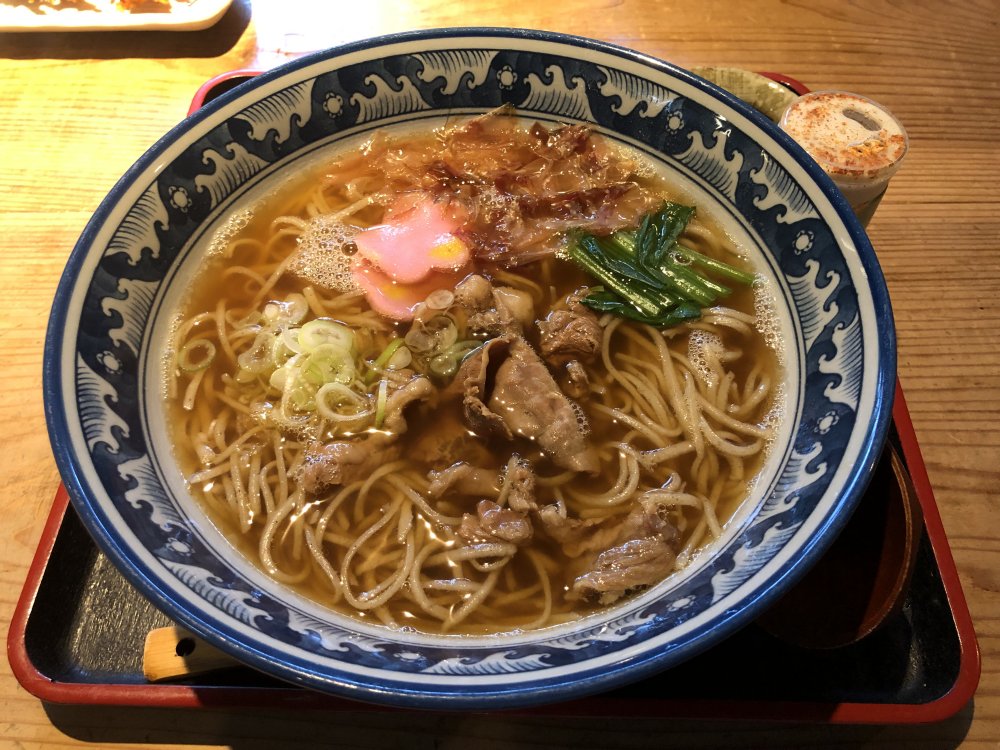
I wanted to try local hand-kneaded Hida soba (teuchi-soba) with an above average strength. I was temped by their featured menu, a warm soba with Hida beef sinew as a topping, and became an imediate fan of both.
Furukawa is unique in that it holds three festivals every year, the Sandera-mairi on January 15th, the Furukawa Festival on April 19th to 20th, and the Kitsunebi (a ghost light phenomenon where light is observed in the dark; most likely so called because foxes (kitsune) were thought to trick people) Festival on the fourth Saturday in September. Of the three festivals, the Kitsunebi Festival based on a folk lore called Fox bride’s Wedding Procession (Kitsune-no-yomeiri) started most recently from 1990, obviously as a Machi-okoshi (town revitalization) measure to support the local economy. The Sandera-mairi, which is to visit the three Buddhist temples of the Jodo-shinshuu sect on January 15th (believed to be the day on which the founder of the sect Shinran died) in remembrance of his virtuous deeds, is thought to have started over 200 (some say 300) years ago in the Edo era. Furukawa Festival is the annual festival of Keta Wakamiya Shinto Shrine. I first paid a visit to the Hida Furukawa Festival Exhibition Hall to obtain a better understanding of the Furukawa Festival.
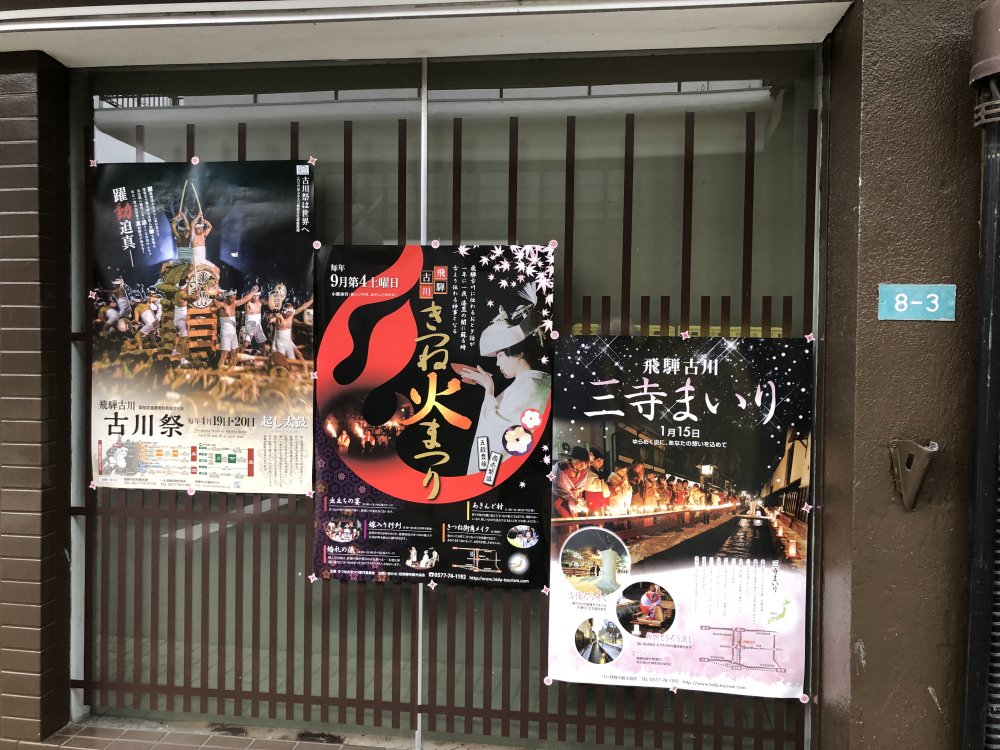
I found pamphlets of Furukawa's three festivals displayed outside the window of the town tourist information center.
The museum displays three out of the ten festival floats (the Kaguradai float to carry the Deity leading the procession and the nine festival floats that follow) on a rotating basis. In addition to opportunity to view the actual size and beauty of the floats, you can learn a lot from the highlights of the festival movie they run every 20 minutes. This was well worth the 700 yen admission fee.
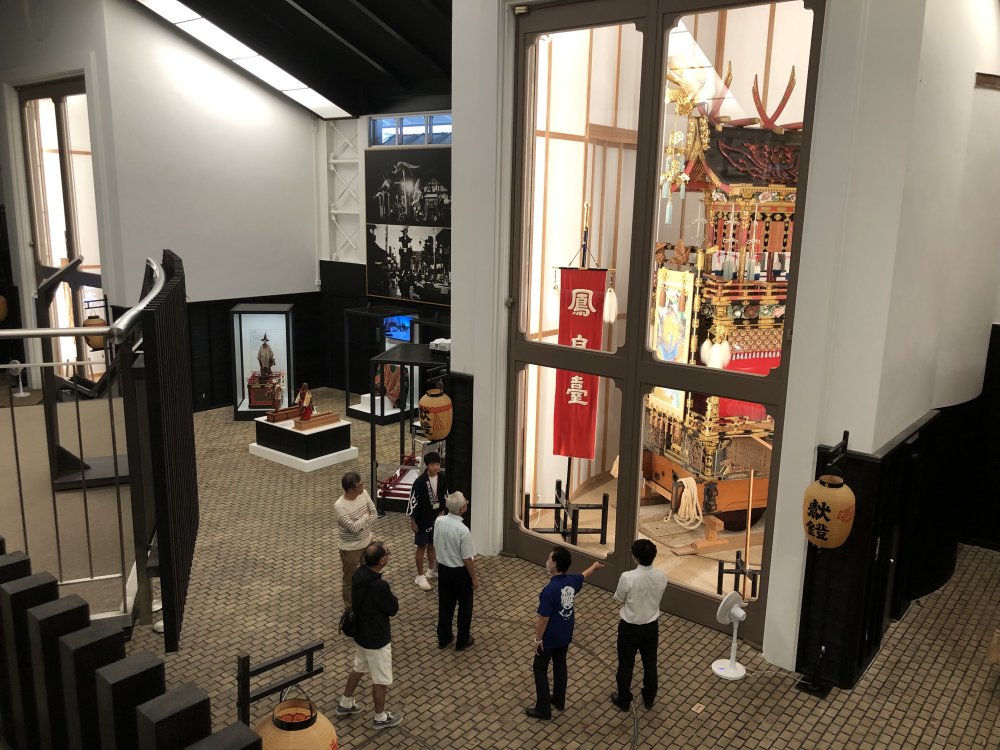
Three out of the ten Furukawa Festival floats are displayed at the museum on a rotating basis. You can learn a lot from the highlights of the festival movie run every 20 minutes.
I then went on to see the Setogawa Canal and White-walled Storehouse Street. The canal was built to segregate the samurai residence area to the east and the merchant district on the west. The area has been beautifully preserved to this day, with many carp swimming in the canal. the white walls are the rear side of the merchant shops.
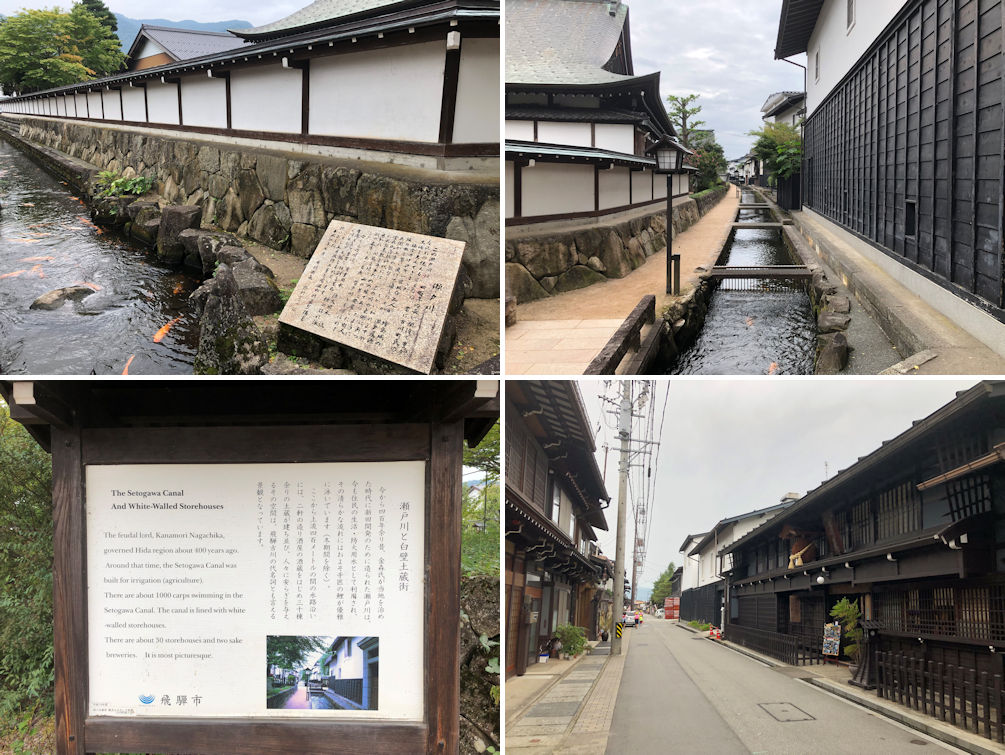
The Setogawa Canal and its carp (upper left), view of the white-walled stores and buildings along the canal towards Enkouji Temple (upper right), explanation provided by Hida City (lower left) and a view of the main street of the merchant area directly on the opposite side of the white-walled stores (lower right).
My next destination was the three temples people visited for the Sandera-mairi. I first visited Enkoji Temple. This temple of the Jodo-shinshuu Buddhist sect was built in 1667, according to the description on the temple site. Its grand temple gate was relocated from Masuyama Castle when it was dismantled as the ruling Kanamori Family were reassigned to a domain in Yamagata Prefecture. The temple miraculously survived through the great fire in 1904, which people believed owed to the turtle engraved in the temple walls under the top box eave.
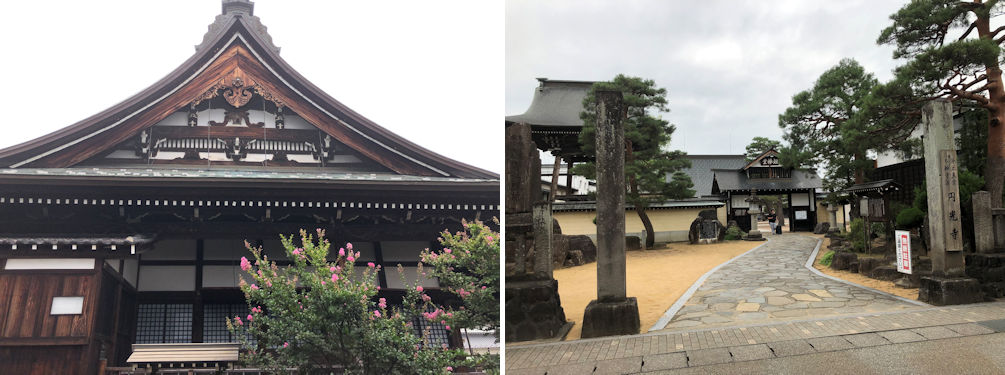
View of the main temple from the canal side (left). The turtle is under the top box eave. Entrance gate of Enkouji Temple. The bell tower, and the temple grounds are beyond the second gate (right).
On my way to the second temple, Honkouji Temple, I noticed one of the two sake breweries in the town. The brewery was on the opposite side of a famous Japanese candle manufacturer on the main street of the merchant district. Unfortunately, the candle maker that supplies all the candle including some gigantic candles weighing more than 10 kgs, was closed on that day. It is incredible that the small town still has two sake breweries. I bought a 720-milliliter bottle of their flagship brand Shiramayumi Tokubetsu-junmai (special pure rice) made from a local sake brewing rice “Hidahomare (Pride of Hida) “.
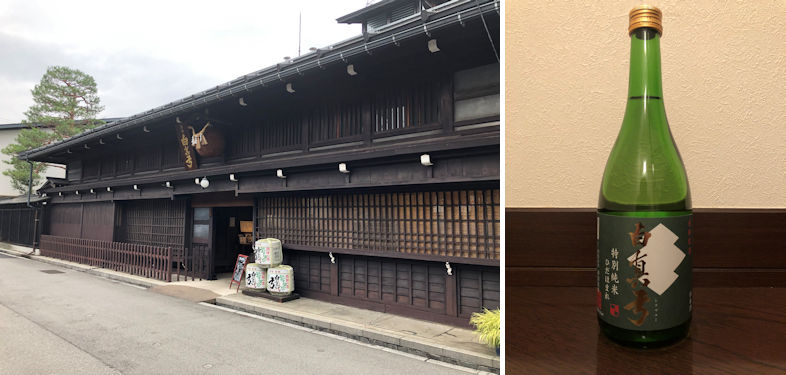
It is incredible that the small town still has two sake breweries. One of the breweries, Kaba Sake Brewery (left). I bought a 720-milliliter bottle of their flagship brand Shiramayumi Tokubetsu-junmai (special pure rice) made from a local sake brewing rice “Hidahomare (Pride of Hida) “.(right).
Honkouji Temple was much grander than I had expected. Founded in the early 16th century, the temple boasts one of the grandest all Japanese cypress (hinoki) main temple building (hondou) and bell tower (shourou). It was a week day and there seemed to be no visitors, and the main temple was closed. It was hard to envisage thousands of visitors visiting this temple on January 15th. The custom of Sandera-mairi expanded from the early Meiji era (1870 onward) as many young girls from the Hida region went to work at silk-reeling factories in the Lake Suwa area in neighboring Nagano Prefecture under severe working conditions (raw silk was the top export product of Japan in those days). It became a custom for girls in their best kimono to perform the Sandera-mairi and pray for their future before leaving the region that they may never see again.
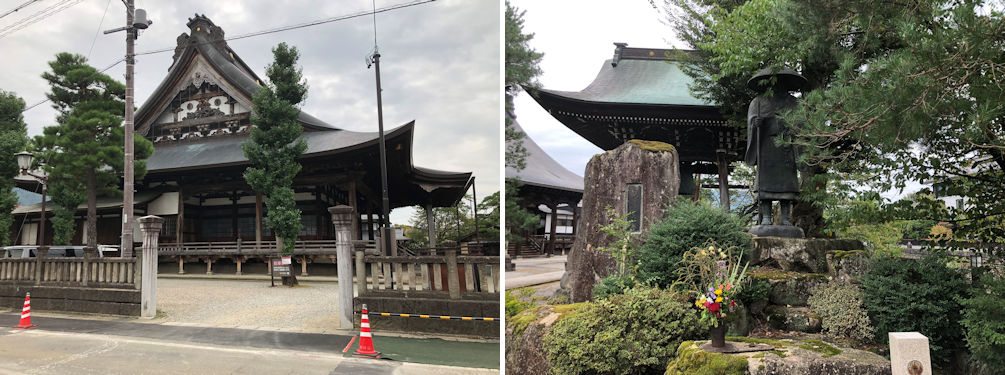
The main temple building (left) and a statue of Shinran, the founder of the Joudo-shinshuu Buddhist sect who people pay respect to in early January (right).
From Honkouji, a couple of minutes’ walk along Arakigawa River took me to the last of the three temples, Shinshuji which is located at the southernmost part of the old township. Originally established in the main area of Shirakawa-go in the early 16th century, the temple was relocated to this site during the reign of the Kanamori Family. Most of the temple buildings were lost in the great fire in Furukawa in 1904. The current main temple building was rebuilt in 1912. The temple together with the adjacent beautiful red Imamiya Bridge over Arakigawa River is a prominent filming location.
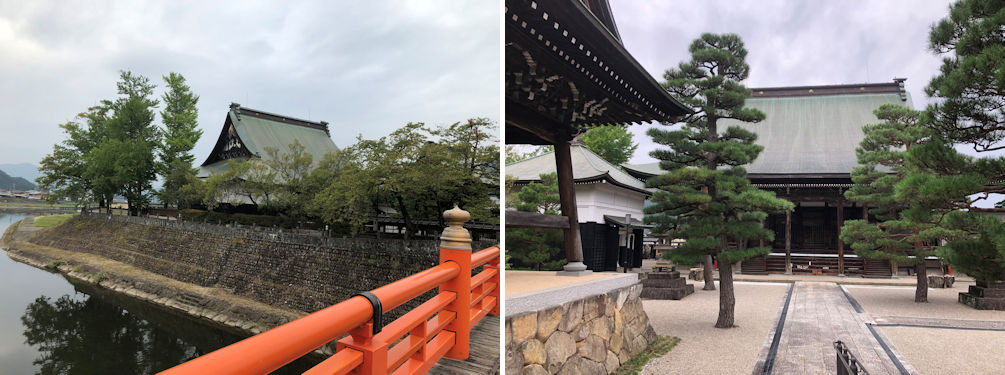
A view of Shinshuji Temple from the adjacent beautiful red Imamiya Bridge over Arakigawa River (left). This is a prominent filming location. The main temple building of Shinshuji Temple (right).
I had watched the anime movie “Your Name” by Makoto Shinkai as many iconic scenes were inspired by sites in Hida Furukawa. One such site is the JR Hida Furukawa Station, where I briefly visited to take some photos of the station from the overhead crossing bridge. It must be a popular place to take photos judging from the train time-table indicating the best photographing times with trains stopping at the station as well as a notice to photographers.
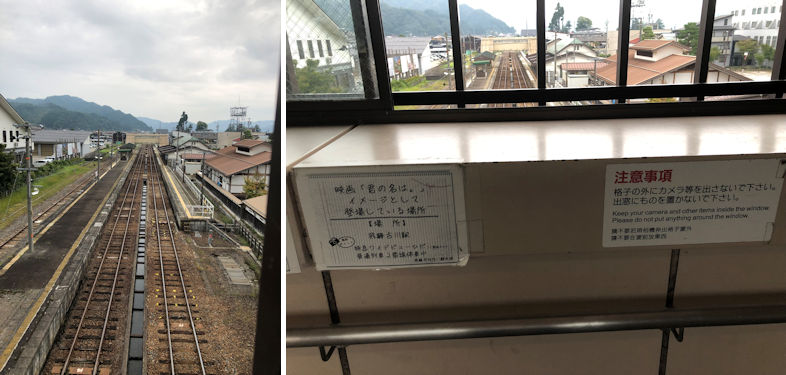
Entrance to the South Inner Enclosure (left). A bird's eye view of the South Inner Enclosure from the watchtower (right).
I explained earlier that Furukawa Festival is the annual festival of Keta Wakamiya Shinto Shrine. Although the local authorities have traced back the history of the festival to the Kanamori Family rein in the early 17th century, my guess is that it originated much earlier, as the shrine appears in historical documents as early as the 9th century. It is also known that prior to the Meiji era, the festival was held in August of Japan’s old calendar, meaning it was held around the autumn equinox in late September, and must have originated as a harvest festival as are many Shinto shrine festivals. According to a travel journal of a Buddhist monk in the late 18th century, there already had nine festival floats in those days, showing that the current festival style has been maintained for well over 200 years. Hida carpenters are renowned for their craftsmanship, and called out throughout Japan for construction and repair work of temples and shrines. One thing that intrigued me so much during my trip to Hida was the pride people have of their craftsmanship, which was also put to work in building and renovating the nine fabulous wooden festival floats.
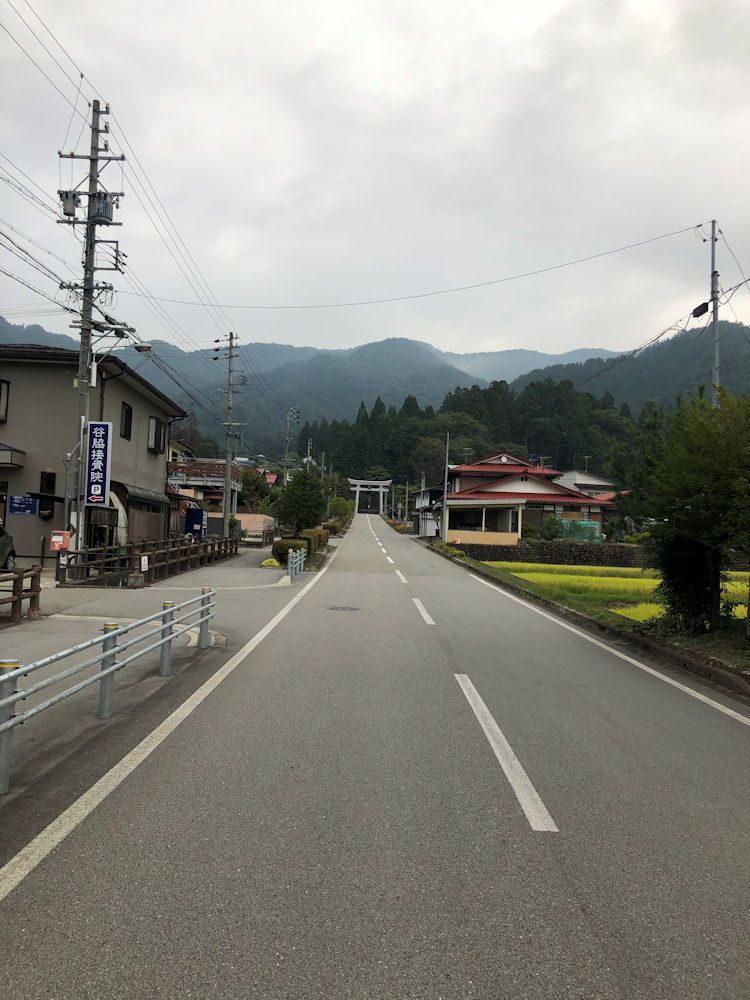
The grand approach to Keta Wakamiya Shinto Shrine. The shrine is located about 1 kilometer east of the Furukawa town district, closer to the mountains, a typical setting for a Shinto shrine.
Keta Wakamiya Shinto Shrine is located about 1 kilometer east of the Furukawa town district, closer to the mountains, a typical setting for a Shinto shrine. I parked at the free car park by the grand entrance torii gate and went up the steps leading to the main shrine area. I understand the steps are briefly featured in the anime movie “Your Name”. The main shrine building and the area in front is of a typical style seen in many shrines in the mountain areas, and is where the Furukawa Festival starts and ends on the second day. I left Furukawa, thinking the visit was much more rewarding than I had expected.
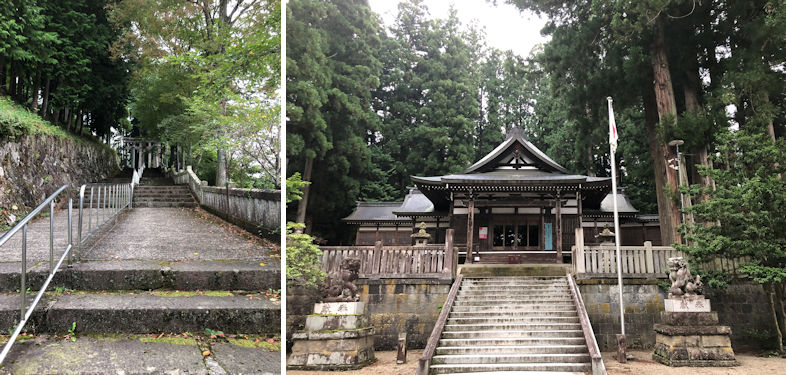
The steps leading to the main shrine area, which briefly featured in the anime movie “Your Name”(left). The main shrine building and the area in front is of a typical style seen in many shrines in the mountain areas (right).